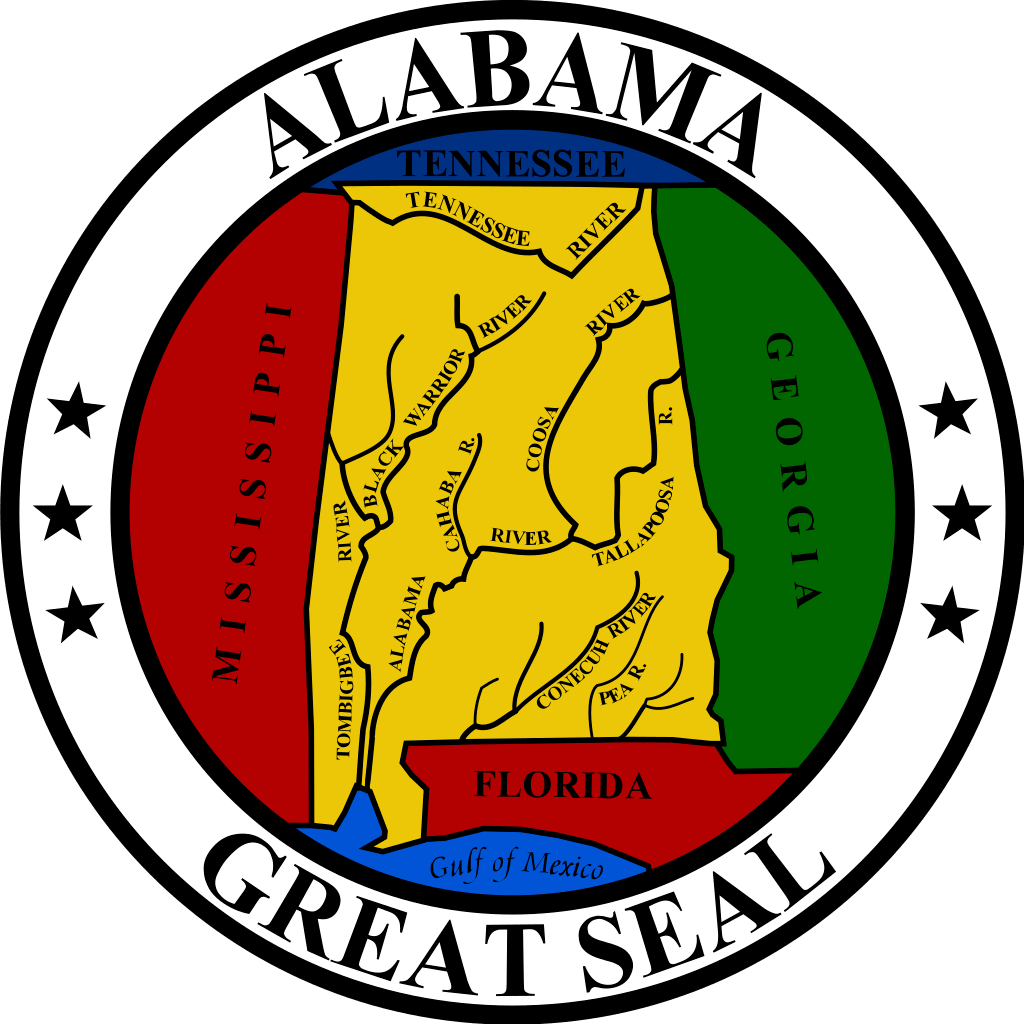In 1895 Alabama began to start adopting its own official state symbols, starting with its flag. State symbols have been a mainstay of U.S. culture since the very beginning. Official symbols are used to represent each state’s cultural heritage and natural history in the most fun way possible.
Alabama, like most other states, has a bunch of symbols that are indicative to the state’s historical roots and geological history. There are also recognizable icons and emblems for each state, such as state seals and flags, nicknames and mottos, and much more which we have included in our Alabama state symbol list.

State Symbols of Alabama
There are a plethora of state symbols for Alabama, and all states for that matter, creating a whole host of interesting facts, both from the past and present. We have created a list of the top 6 most significant Alabama state symbols below, and at the bottom of this article, you will find a comprehensive table with each Alabama symbol and the date in which they were officially created.
Alabama State Animals
The famous black bear (Ursus americanus) has been the official Alabama state mammal since 1996. Like a few other states, Alabama does not have an official state animal; instead, the state uses a land mammal and a sea mammal to represent it.
Black bears are incredibly intelligent, shy, and introverted animals, for the most part. Coming across one of these in the wild is not that common as they are so secretive and shy. They also sport more colors than just black. There are cinnamon, white, beige, and even blue-colored black bears spotted around North America!
Typically, adult black bears vary considerably in size, going from 150 lbs (pounds) to 500 lbs (pounds)! Their diet consists of just about anything they can get their paws on, but as a rule, they tend to eat nuts, berries, grass, and roots in the wild. Additionally, they will eat insects and small mammals as a rare treat.
An estimated 600,000 black bears reside in North America and 300,000 in the United States.

The next animal to represent Alabama is the sea mammal, the West Indian manatee (Trichechus manatus). This incredibly unique marine mammal has been the official state marine mammal since 2009, when aquatic state symbols came into effect in Alabama.
In March 2017, the United States Fish and Wildlife Service announced that these “sea cows” were no longer endangered or threatened species due to improvements in their natural habitat and water conditions. Today, there are around 13,000 manatees residing in the wild.
Alabama State Fruit
The peach (Rosacea, genus prunus) has been the official state fruit for Alabama since 2006. Previously, the fruit to represent the state was the blackberry, which was originally adopted in 1949. Funnily enough, it is not just Alabama that has the peach as the official state fruit. The state of Georgia also uses the peach as its state fruit and state nickname!

Alabama State Bird and Flower
The yellowhammer became the official state bird of Alabama in 1927, the official name of this bird is actually the northern flicker. Alabama is the only one out of all 50 states that recognizes a woodpecker species as the official state bird. In addition to the Alabama state bird, Albama also adopted a state game bird in 1980. Take a look at our table below to see what it is!

Camellias are some of the purest and most beautiful flowers in the world, and they have been the flower to represent the state of Alabama since 1959, replacing the goldenrod flower, which was adopted in 1927. You will see camellias appear on Alabama’s state quarter too.
Alabama State Seal
The Alabama state seal was originally designed in 1817 by the first-ever governor of the Alabama Territory, William Wyatt Bibb. The seal itself displays the major rivers that run through the state, and that have played a significant role in the history of Alabama over the years.

Alabama’s seal design is a map of the Alabama territory, and its surrounding territories, which are all now states. Alabama was first granted statehood in 1819 and the official state seal design remains unchanged today, unlike many other U.S. states.
During the Civil War of 1868 a new state seal of Alabama was created, sporting an eagle that is standing on the American shield clutching a banner in its beak that reads “Here We Rest”.
Alabama State Insect
Like many other states, Alabama has adopted the monarch butterfly (Danaus plexippus) as the official state insect. It was in 1989 when the butterfly was officially adopted as the insect state symbol; however, in addition to this, Alabama has adopted an agricultural insect, which is the queen honeybee!

Alabama State Tree
Alabama’s official state tree is the longleaf pine and has been since 1949. These beautiful yet unique pine trees used to cover over 90 million acres in the southeastern corner of the United States! Nowadays, their population has unfortunately faced a decline, and over 30 different plant and animal species that are associated with the pine are threatened or endangered.

All Alabama State Symbols (Table)
Now that we have looked at some of the more popular and notable state symbols that are associated with the great state of Alabama, it makes sense to showcase all the Alabama state symbols that are best used to represent the state’s historical and more present achievements and moments. Here is the complete list of symbols and their associated dates of enactment:
| Type Of Symbol | State Symbol | Year |
|---|---|---|
| Alabama State Agricultural Insect | Queen honey bee | 2015 |
| Alabama State Agricultural Museum | Dothan Landmarks Parks | 1992 |
| Alabama State American Folk Dance | Square dance | 1981 |
| Alabama State Amphibian | Red Hills Salamander (Phaeognathus hubrichti Highton, 1961) | 2000 |
| Alabama State Barbeque Championship | Christmas on the River Barbeque Cookoff | 1991 |
| Alabama State Bird | Yellowhammer (Colaptes auratus) | 1927 |
| Alabama State Butterfly | Eastern Tiger Swallowtail (Pterourus glaucus) | 1989 |
| Alabama State Cake | Lane cake | 2016 |
| Alabama State Crustacean | Brown shrimp (Penaeus aztecus) | 2015 |
| Alabama State Flag | Civil and State Flag | 1895 |
| Alabama State Flower | Camellia (Camellia japonica L.) | 1959 |
| Alabama State Fossil | Basilosaurus cetoides | 1984 |
| Alabama State Freshwater Fish | Largemouth Bass (Micropterus salmoides) | 1975 |
| Alabama State Fruit | Blackberry (Rubus occidentalis L.) | 2004 |
| Alabama State Game Bird | Wild Turkey (Meleagris gallopavo) | 1980 |
| Alabama State Gemstone | Star Blue Quartz | 1990 |
| Alabama State Seal | Seal of the State of Alabama | 1939 |
| Alabama State Historic Theatre | Alabama Theatre for the Performing Arts | 1993 |
| Alabama State Horse | Racking Horse | 1975 |
| Alabama State Horse Show | The Alabama Championship Horse Show | 1988 |
| Alabama State Horseshoe Tournament | Stockton Fall Horseshoe Tournament | 1992 |
| Alabama State Insect | Monarch butterfly (Danaus plexippus) | 1989 |
| Alabama State Literary Capital of Alabama | Monroeville and Monroe County | 1997 |
| Alabama State Mammal | Black bear (Ursus americanus) | 2006 |
| Alabama State Marine Mammal | West Indian manatee (Trichechus manatus) | 2009 |
| Alabama State Mascot | Eastern tiger swallowtail (Pterourus glaucus) | 1989 |
| Alabama State Mineral | Red Iron Ore (Hematite) | 1967 |
| Alabama State Nut | Pecan | 1982 |
| Alabama State Quilt | Pine Burr Quilt | 1997 |
| Alabama State Renaissance Faire | Florence Renaissance Faire ( Web site ) | 1988 |
| Alabama State Reptile | Red-Bellied Turtle (Pseudemys alabamensis) | 1990 |
| Alabama State Rock | Marble | 1969 |
| Alabama State Saltwater Fish | Tarpon (Megalops atlanticus) | 1955 |
| Alabama State Shell | Johnstone's Junonia (Scaphella junonia johnstoneae) | 1990 |
| Alabama State Soil | Bama Soil Series | 1997 |
| Alabama State Song | "Alabama," words by Julia S. Tutwiler and music by Edna Gockel-Gussen | 1931 |
| Alabama State Spirit | Conecuh Ridge Alabama Fine Whiskey | 2004 |
| Alabama State Tree | Southern Longleaf Pine (Pinus palustris Miller) | 1949 |
| Alabama State Tree fruit | Peach | 2006 |
| Alabama State Wildflower | Oak-leaf Hydrangea (Hydrangea quercifolia Bartram) | 1999 |


